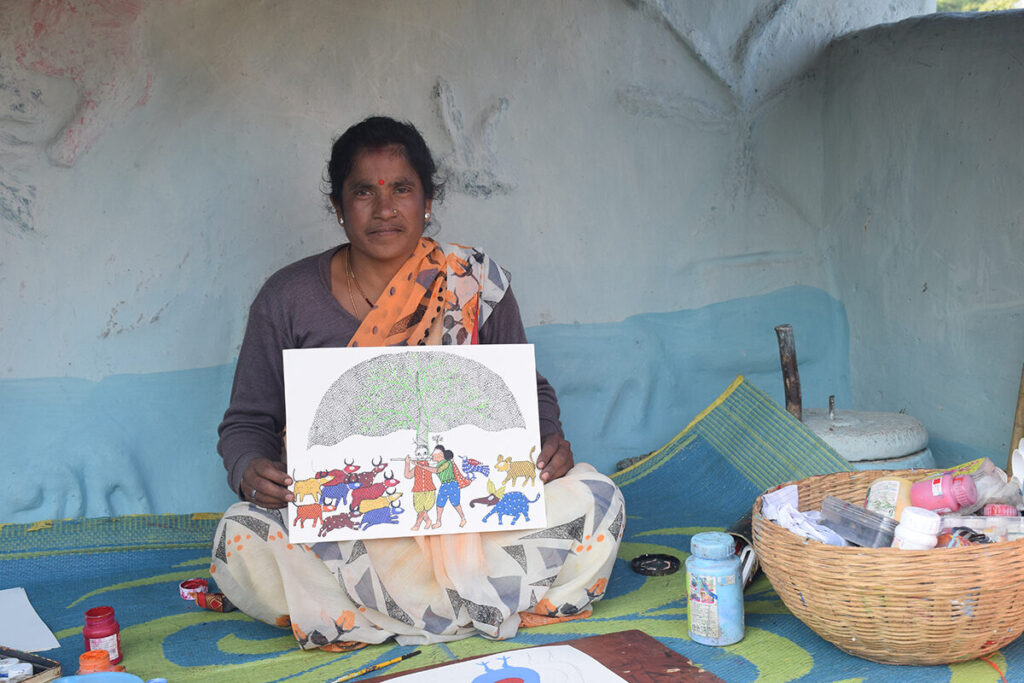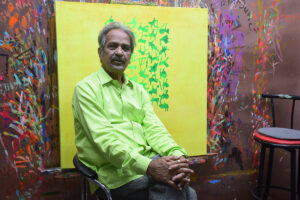Tribal Artists: Converting Folklore To Fine Art
Mar 12, 2024 | Pratirodh Bureau
Champi Bai displays her art after hours of dedicated work (Photo by Manish Chandra Mishra/Mongabay)
- Gond art was historically painted on the walls of tribal homes with natural pigments and accompanied by Bana, a musical tradition of folklores. The art form has undergone changes in recent years to include chemical colours and canvases.
- Patangarh, a village in Madhya Pradesh is considered the seat of Gond art, nurturing talents of over 250 skilled artists specialised in the traditional art form.
- Gond art received international acclaim when one of the local artists – Jangarh Singh Shyam – took it to the world stage and opened up a global market for the tribal art.
Situated atop a hill, 50 km from the district headquarters of Dindori in Madhya Pradesh, is the village of Patangarh. During a visit here, earlier this year, the village resonated with the enchanting melody of a folk song sung in the Gondi dialect. Narrating the tales of a Gond king, the vocals were accompanied by the rhythmic strumming of Bana, an indigenous musical instrument.
Not far from the peepal tree where musician Narayan Singh Tekam captivated the audience with his performance, Gond paintings adorned the walls of Hastkala Bhavan, a centre for art in the village, depicting scenes intricately woven into the narrative of the song. In Patangarh, a village with a population of 213 families (as per 2011 census), a significant portion of the community is engaged in the vibrant art of Gond.
Gond artist Ram Kumar Shyam draws inspiration from these age-old folktales featured in Bana for his paintings. “The melodies of Bana echo throughout our village, recounting stories that span from the genesis of the earth to the heroic battles of Gond kings. In our art, we strive to capture the rich tapestry of nature depicted in these narratives,” he explains.
Ram’s elder brother, Padma Shri awardee artist Bhajju Shyam, focuses his artistic endeavours on themes deeply rooted in Gond culture, particularly revolving around the Gond Ramayana and Mahabharata, which are different from the popular narratives of the epics. For instance, Lord Ram’s brother Lakshman is often depicted as the hero in Gond Ramayana and Bheem is the hero in Gond Mahabharata. The art also takes inspiration from mythologies linked to the earth, moon, and sun, as well as nature.
Bana is the driving force behind Gond painting, says Bhajju, infusing his work with the essence of the music. “I recognised 15 years ago that this traditional style of singing and storytelling was gradually fading away. So, I embarked on a mission to revive it in my village. Presently, around 15 Bana singers in the region are dedicated to this art form,” he explains.
Inspired By The Artistry Of Nature
Gond art distinguishes itself by the use of geometric patterns and motifs drawn from nature, including curved lines, fish shapes, water droplets, seeds and more. Traditionally, these artworks were deeply intertwined with nature, featuring birds and animals such as peacocks, lizards, lions, crabs, monkeys, pigs and cows as prominent subjects. However, in recent times, elements of modernity, such as airplanes, bicycles, cars and technology, are expressed in Gond art. The Mahua tree holds particular significance in these creations, with its flowers, fruits, seeds and leaves depicted using natural dyes.
Through diverse elements, Gond artists portray the rich tapestry of myths, legends and everyday life experiences of the Gond people. Additionally, Hindu deities like Lord Shiva, Lord Krishna and Lord Ganesha coexist with local deities such as Phulvari Devi (goddess Kali), Jalharin Devi (river goddess) and Marahi Devi, further enriching the narrative and spiritual dimensions of their artworks.
Traditionally, Gond painting has been characterised by the use of natural pigments. According to information published in the Geographical Indications Journal of Intellectual Property India, Gond artists used charcoal for black colour, Ramraj soil for yellow, Chui soil for white, Geru soil for red and cow dung or dark green for green leaves as pigments. However, over time, chemical colours were introduced into this art form.
Bhajju expresses concern over the diminishing availability of natural colours which the tribal people used to collect from the forest. “Many areas in the forest surrounding our village contained red or white soil,” he informs. According to him, a few fatal accidents during soil collection in the past prompted the government to enforce a complete ban on the practice. “Natural soil is no longer accessible, and we now rely on synthetic colours,” he shares, disapprovingly.
Taking The World Stage
Gond art, much like many other tribal art forms, was traditionally informal and spontaneous, often created on the walls of tribal dwellings or on floors during significant events such as births or weddings.
It remained largely localised until the late 1980s when artist Jangarh Singh Shyam propelled it onto the global stage.
Jangarh, a highly acclaimed artist whose works have been showcased worldwide in cities like Delhi, Tokyo and New York, transitioned Gond art from its traditional canvas of walls and floors to formal canvases, unlocking a realm of possibilities for his fellow Gond artists.
He passed away in 2001 at the age of 39, leaving behind a profound legacy. His nephews, Ram and Bhajju, who received their artistic education under Jangarh’s guidance, carry forward his artistic vision, perpetuating what has now become known as the Jangarh Kalam style.

Growing Market Poses Challenges
Sitting a few steps away from the peepal tree, Champi Bai Shyam focuses on her latest painting. Specialised in the traditional art form of Dhigna, using geometrical patterns done in a courtyard, with various coloured clays and traditional pigments, she learned Gond art on canvas when she moved to Patangarh after her marriage to artist Ram Kumar Shyam, Bhajju’s brother. Champi Bai’s paintings, executed on A4 size canvases, are priced at Rs. 2000 to Rs. 4,000. “My art has been sold in online art exhibitions in America. I showcase them at exhibitions or fairs in Bhopal and Delhi,” Champi Bai shares. Ram had to abandon his livelihood in woodwork to pursue Gond art, a significantly more lucrative endeavour that also spared him regular run-in with the forest department.
In 2023, Gond painting from Madhya Pradesh was granted the Geographical Indication tag. This recognition was jointly bestowed upon the Tejaswini Mekalsuta Mahasangh Gorakhpur Committee and Vanya, an organisation under the Tribal Affairs Department of the Madhya Pradesh government. Many government institutions like Bhopal-based Indira Gandhi Rashtriya Manav Sangrahalaya (IGRMS) have been organising exhibitions of Gond paintings for many years, contributing to its visibility and promotion. The museum has conducted close to 150 workshops on its premises and in other states across the country, according to the museum’s Public Relations Officer, Ashok Sharma.
The Gond art market has undergone significant transformation since the days when young Jangarh sold his art for around Rs. 1500 each. Today, according to Akhilesh, Gond paintings command prices a hundred times higher. “This art has provided dignified employment for tribal artists,” he asserts. Ram points out that many of the village artists have migrated to Bhopal, where they pursue the art alongside other jobs.
Bhajju says that Gond art is typically priced anywhere from Rs. 2,000 to Rs. 60,000. There are also cases where it was sold for Rs. 100,000 or more, depending on the artist’s reputation. One of his paintings was once sold for Rs. 400,000, he recounts.
While the growing market for Gond art excites artists like Bhajju, they are also concerned about the commercialisation of the traditional art. He advises artists to not lose sight of their roots and to preserve the integrity of the art by staying away from mass producing the art for monetary gains.
After carefully stowing away his instrument following the hour-long performance of folk songs, Tekam reflects on his role as a custodian of tradition, eager to impart his musical legacy to future generations. He highlights that there is no Gond painting without the tradition of Bana recitals and that it is difficult to separate the two. “Bana is the essence of Gond art, serving as its foundation and sustaining its spirit,” Tekam says as he prepares to leave after offering a coconut to the fire and collecting the rice and money offered by villagers as donation.
(Published under Creative Commons from Mongabay-India. Read the original article here)
